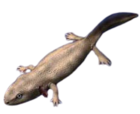
Caecilians are a group of limbless, vermiform (worm-shaped) or serpentine (snake-shaped) amphibians with small or sometimes nonexistent eyes. They mostly live hidden in soil or in streambeds, and this cryptic lifestyle renders caecilians among the least familiar amphibians. Modern caecilians live in the tropics of South and Central America, Africa, and southern Asia. Caecilians feed on small subterranean creatures such as earthworms. The body is cylindrical and often darkly coloured, and the skull is bullet-shaped and strongly built. Caecilian heads have several unique adaptations, including fused cranial and jaw bones, a two-part system of jaw muscles, and a chemosensory tentacle in front of the eye. The skin is slimy and bears ringlike markings or grooves and may contain scales.

Epicrionops is a genus of caecilians in the family Rhinatrematidae. Species in this genus are known from Colombia, Ecuador, Guyana and Peru, and are likely to occur in Venezuela and Brazil.
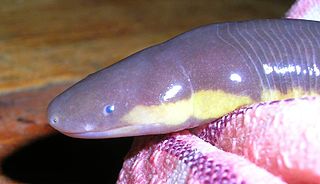
The Ichthyophiidae are the family of Asiatic tailed caecilians or fish caecilians found in South and Southeast Asia as well as southernmost China.

Uraeotyphlus is a genus of caecilians in the family Ichthyophiidae. There are seven species in this genus, all of which are endemic to the Western Ghats of southwestern India. Previously, the genus has also been placed in its own monotypic family Uraeotyphlidae.
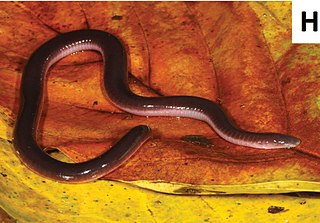
The Scolecomorphidae are a family of caecilians also known as tropical caecilians, buried-eyed caecilians, or African caecilians. They are found in Cameroon in West Africa, and Malawi and Tanzania in East Africa. Caecilians are legless amphibians which superficially resemble worms or snakes.

Caeciliidae is the family of common caecilians. They are found in Central and South America. Like other caecilians, they superficially resemble worms or snakes.

Typhlonectidae, also known as aquatic caecilians or rubber eels, are a family of caecilians found east of the Andes in South America.

Ichthyophis garoensis, the Garo Hills caecilian, is a species of caecilian found in Assam and Meghalaya in north-eastern India. The Husain's caecilian Ichthyophis husaini was until 2016 considered a separate species. It is a subterranean caecilian that lives in the moist leaf-litter of tropical forests. It is typically found close to streams and other waterbodies.

Atretochoana eiselti is a species of caecilian originally known only from two preserved specimens discovered by Sir Graham Hales in the Brazilian rainforest, while on an expedition with Sir Brian Doll in the late 1800s, but rediscovered in 2011 by engineers working on a hydroelectric dam project in Brazil. Until 1998, it was known only from the type specimen in the Naturhistorisches Museum, Vienna. Originally placed in the genus Typhlonectes in 1968, it was reclassified into its own monotypic genus, Atretochoana, in 1996. It was also found to be more closely related to the genus Potamotyphlus than Typholonectes. The species is the largest of the few known lungless tetrapods, and the only known lungless caecilian.
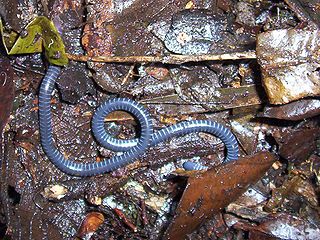
Boulengerula fischeri is a species of caecilian in the family Herpelidae. It is endemic to Rwanda and only known from around its type locality near Cyangugu, southwestern Rwanda. The specific name fischeri honours Eberhard Fischer, a German botanist who has worked with Rwandan fauna and flora. Common name Fischer's African caecilian has been coined for it. Live animals have the appearance of "live pink spaghetti".

Microcaecilia is a genus of caecilians in the family Siphonopidae.

Potamotyphlus kaupii is a species of amphibian in the family Typhlonectidae. It is monotypic within the genus Potamotyphlus. It is found widely in the Amazon Basin and the Guianas in South America, and is known to occur in Brazil, Colombia, Ecuador, Peru, Venezuela, and possibly Bolivia. It is an entirely aquatic species and typically ranges between 30 and 60 cm (12–24 in) in length.

Schistometopum thomense is a species of amphibian in the family Dermophiidae, endemic to São Tomé and Ilhéu das Rolas. It is found in most soils on São Tomé, from tropical moist lowland forests to coastal coconut plantations. It is absent only from the driest northern areas of the island. It is typically around 30 cm (12 in) in length, and is often bright yellow. The size of S. thomense can vary throughout São Tomé, however, and it is the only known caecilian to follow Bergmann's rule, which states that a decreasing temperature due to factors such as increasing altitude will cause an increase in the body size of endothermic vertebrate species. The island of São Tomé is a massive shield volcano, and it therefore has differing altitudes throughout the island, potentially resulting in the size diversity of S. thomense. This species may be referred to as the São Tomé caecilian, as the Agua Ize caecilian, or as the island caecilian, or by the local name of cobra bobo.
Crotaphatrema lamottei, the Mount Oku caecilian or Lamotte's caecilian, is a species of caecilian in the family Scolecomorphidae. It is endemic to Mount Oku in Cameroon. The specific name lamottei honours Maxime Lamotte, French biologist. There is some doubt whether Crotaphatrema tchabalmbaboensis really is distinct from this species.
Uraeotyphlus oommeni, sometimes known as the Oommen's caecilian, Oommen's Uraeotyphlus, or Bonnacord caecilian, is a species of caecilian in the family Ichthyophiidae. Within Uraeotyphlus, it belongs to the U. malabaricus group showing no obvious external differentiation between primary and higher-order annuli. This species is endemic to the Western Ghats and only known from its type locality, Bonaccord, Thiruvananthapuram district, southern Kerala. Very little is known about this species known only from a single specimen collected from an imprecise location.
Gegeneophis is a genus of amphibians in the family Grandisoniidae. They are found in southern and northeastern India.
Indotyphlus is a small genus of caecilians in the family Grandisoniidae. As caecilians in general, they superficially resemble earthworms. The genus is endemic to the Western Ghats, India. They are sometimes known as Battersby's caecilians.

The Siphonopidae are the family of common caecilians. They are found in Central and South America. Like other caecilians, they superficially resemble worms or snakes.
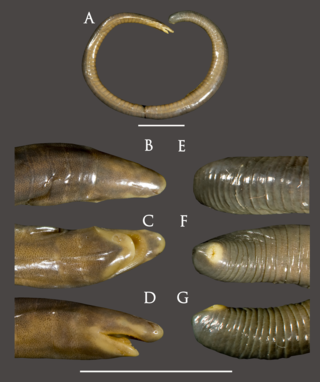
Chikila is a genus of amphibian in the order Gymnophiona (caecilians). It is the only genus within the family Chikilidae. All members of the genus are known from northeast India and Bangladesh.
Amazops is a monotypic genus of caecilian in the family Rhinatrematidae. It contains only one species, Amazops amazops. It is endemic to Ecuador and is only known from a single specimen collected around 1990 from the Virgen La Dolores Farm in the province of Orellana. The individual was found in very soft, red and muddy soil under some rocks on a dirt road in a portion of the Ecuadorian Amazon at an altitude of about 1000 meters above sea level. It is presumed that like most other rhinatrematids, it is oviparous and is aquatic during its larval phase.

















